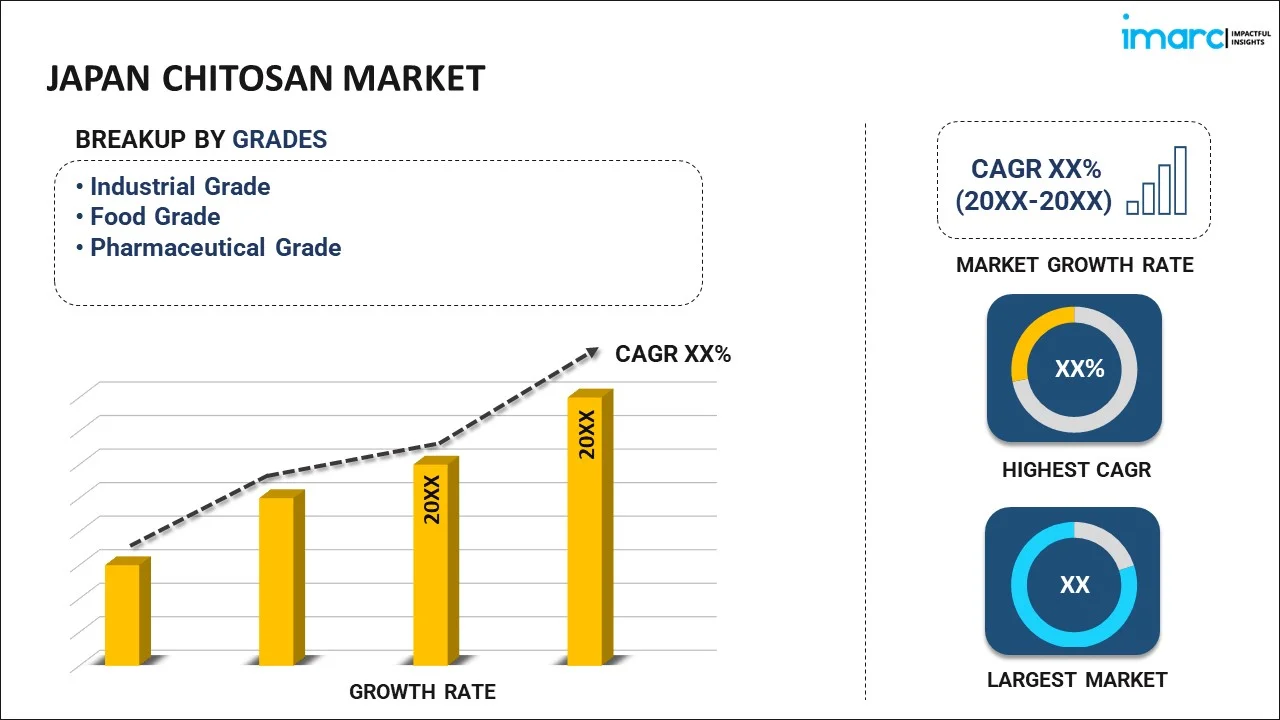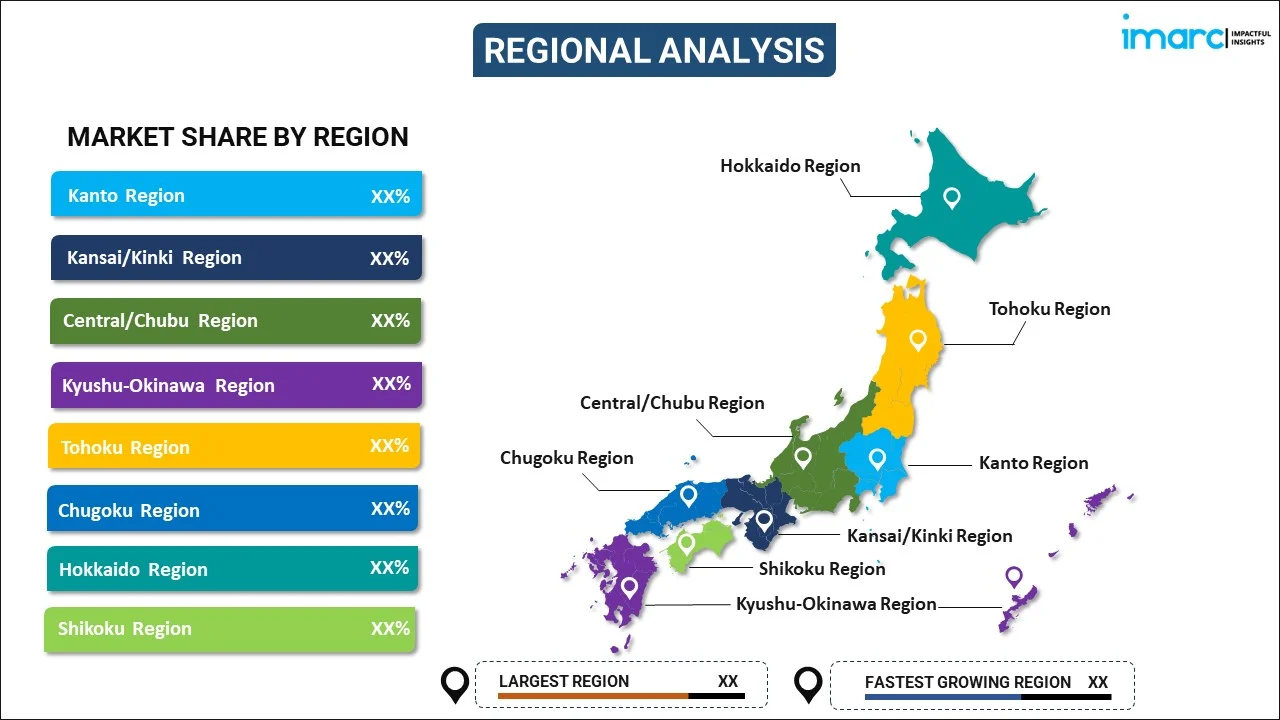
Japan Chitosan Market Report by Grade (Industrial Grade, Food Grade, Pharmaceutical Grade), Source (Shrimp, Crab, Squid, Krill, and Others), Application (Water Treatment, Food and Beverages, Cosmetics, Medical and Pharmaceuticals, Agrochemicals, and Others), and Region 2025-2033
Market Overview:
Japan chitosan market size reached USD 98.6 Million in 2024. Looking forward, IMARC Group expects the market to reach USD 256.2 Million by 2033, exhibiting a growth rate (CAGR) of 10.4% during 2025-2033. The emerging popularity of chitosan-based items due to their potential as biodegradable and antimicrobial packaging materials, which can help reduce plastic waste and improve food safety, is driving the market.
|
Report Attribute
|
Key Statistics
|
|---|---|
|
Base Year
|
2024
|
|
Forecast Years
|
2025-2033
|
|
Historical Years
|
2019-2024
|
|
Market Size in 2024
|
USD 98.6 Million |
|
Market Forecast in 2033
|
USD 256.2 Million |
| Market Growth Rate 2025-2033 | 10.4% |
Chitosan is a natural biopolymer derived from chitin, a substance found in the shells of crustaceans like shrimp and crabs. It is a white, odorless powder with a wide range of applications in various industries. Chitosan is valued for its remarkable properties, including biodegradability, biocompatibility, and non-toxicity. In the field of medicine, chitosan is used in wound dressings and drug delivery systems due to its ability to promote tissue regeneration and controlled drug release. It is also employed in weight loss supplements, where its fibrous structure can bind to dietary fats, potentially aiding in weight management. Additionally, chitosan is utilized in agriculture as a natural pesticide and soil conditioner, helping to improve crop yields and reduce the need for chemical fertilizers and pesticides. In water treatment, it serves as a flocculant to remove impurities and pollutants. Chitosan's versatility makes it a valuable material with diverse applications across health, agriculture, and environmental sectors, offering sustainable and eco-friendly solutions to various challenges.
Japan Chitosan Market Trends:
The chitosan market in Japan is experiencing robust growth due to a combination of several key drivers. Firstly, the increasing awareness of the environmental impact of synthetic chemicals has led to a rising demand for natural and eco-friendly alternatives. Consequently, chitosan, derived from chitin found in crustacean shells, has gained prominence as a sustainable and biodegradable material, propelling its market growth. Moreover, the expanding applications of chitosan across various industries, including pharmaceuticals, agriculture, and food and beverage, have fueled its market demand. As a versatile substance, chitosan exhibits properties such as antimicrobial activity, wound-healing capabilities, and plant growth stimulation, making it a sought-after ingredient in these sectors. Furthermore, the growing focus on health and wellness has driven the incorporation of chitosan in dietary supplements and weight management products. Its ability to bind to dietary fats and cholesterol in the digestive system appeals to health-conscious consumers, contributing to market expansion. Lastly, numerous governmental regulations and policies promoting sustainable practices and eco-friendly materials have created a conducive environment for chitosan's market growth. These drivers collectively underscore the promising trajectory of the chitosan market in Japan, with continued expansion expected in the years to come.
Japan Chitosan Market Segmentation:
IMARC Group provides an analysis of the key trends in each segment of the market, along with forecasts at the country level for 2025-2033. Our report has categorized the market based on grade, source, and application.
Grade Insights:

- Industrial Grade
- Food Grade
- Pharmaceutical Grade
The report has provided a detailed breakup and analysis of the market based on the grade. This includes industrial grade, food grade, and pharmaceutical grade.
Source Insights:
- Shrimp
- Crab
- Squid
- Krill
- Others
A detailed breakup and analysis of the market based on the source have also been provided in the report. This includes shrimp, crab, squid, krill, and others.
Application Insights:
- Water Treatment
- Food and Beverages
- Cosmetics
- Medical and Pharmaceuticals
- Agrochemicals
- Others
The report has provided a detailed breakup and analysis of the market based on the application. This includes water treatment, food and beverages, cosmetics, medical and pharmaceuticals, agrochemicals, and others.
Regional Insights:

- Kanto Region
- Kansai/Kinki Region
- Central/ Chubu Region
- Kyushu-Okinawa Region
- Tohoku Region
- Chugoku Region
- Hokkaido Region
- Shikoku Region
The report has also provided a comprehensive analysis of all the major regional markets, which include Kanto Region, Kansai/Kinki Region, Central/ Chubu Region, Kyushu-Okinawa Region, Tohoku Region, Chugoku Region, Hokkaido Region, and Shikoku Region.
Competitive Landscape:
The market research report has also provided a comprehensive analysis of the competitive landscape in the market. Competitive analysis such as market structure, key player positioning, top winning strategies, competitive dashboard, and company evaluation quadrant has been covered in the report. Also, detailed profiles of all major companies have been provided.
Japan Chitosan Market Report Coverage:
| Report Features | Details |
|---|---|
| Base Year of the Analysis | 2024 |
| Historical Period | 2019-2024 |
| Forecast Period | 2025-2033 |
| Units | Million USD |
| Scope of the Report | Exploration of Historical Trends and Market Outlook, Industry Catalysts and Challenges, Segment-Wise Historical and Future Market Assessment:
|
| Grades Covered | Industrial Grade, Food Grade, Pharmaceutical Grade |
| Sources Covered | Shrimp, Crab, Squid, Krill, Others |
| Applications Covered | Water Treatment, Food and Beverages, Cosmetics, Medical and Pharmaceuticals, Agrochemicals, Others |
| Regions Covered | Kanto Region, Kansai/Kinki Region, Central/ Chubu Region, Kyushu-Okinawa Region, Tohoku Region, Chugoku Region, Hokkaido Region, Shikoku Region |
| Customization Scope | 10% Free Customization |
| Post-Sale Analyst Support | 10-12 Weeks |
| Delivery Format | PDF and Excel through Email (We can also provide the editable version of the report in PPT/Word format on special request) |
Key Questions Answered in This Report:
- How has the Japan chitosan market performed so far and how will it perform in the coming years?
- What has been the impact of COVID-19 on the Japan chitosan market?
- What is the breakup of the Japan chitosan market on the basis of grade?
- What is the breakup of the Japan chitosan market on the basis of source?
- What is the breakup of the Japan chitosan market on the basis of application?
- What are the various stages in the value chain of the Japan chitosan market?
- What are the key driving factors and challenges in the Japan chitosan?
- What is the structure of the Japan chitosan market and who are the key players?
- What is the degree of competition in the Japan chitosan market?
Key Benefits for Stakeholders:
- IMARC’s industry report offers a comprehensive quantitative analysis of various market segments, historical and current market trends, market forecasts, and dynamics of the Japan chitosan market from 2019-2033.
- The research report provides the latest information on the market drivers, challenges, and opportunities in the Japan chitosan market.
- Porter's five forces analysis assist stakeholders in assessing the impact of new entrants, competitive rivalry, supplier power, buyer power, and the threat of substitution. It helps stakeholders to analyze the level of competition within the Japan chitosan industry and its attractiveness.
- Competitive landscape allows stakeholders to understand their competitive environment and provides an insight into the current positions of key players in the market.
Need more help?
- Speak to our experienced analysts for insights on the current market scenarios.
- Include additional segments and countries to customize the report as per your requirement.
- Gain an unparalleled competitive advantage in your domain by understanding how to utilize the report and positively impacting your operations and revenue.
- For further assistance, please connect with our analysts.
 Inquire Before Buying
Inquire Before Buying
 Speak to an Analyst
Speak to an Analyst
 Request Brochure
Request Brochure
 Request Customization
Request Customization




.webp)




.webp)












